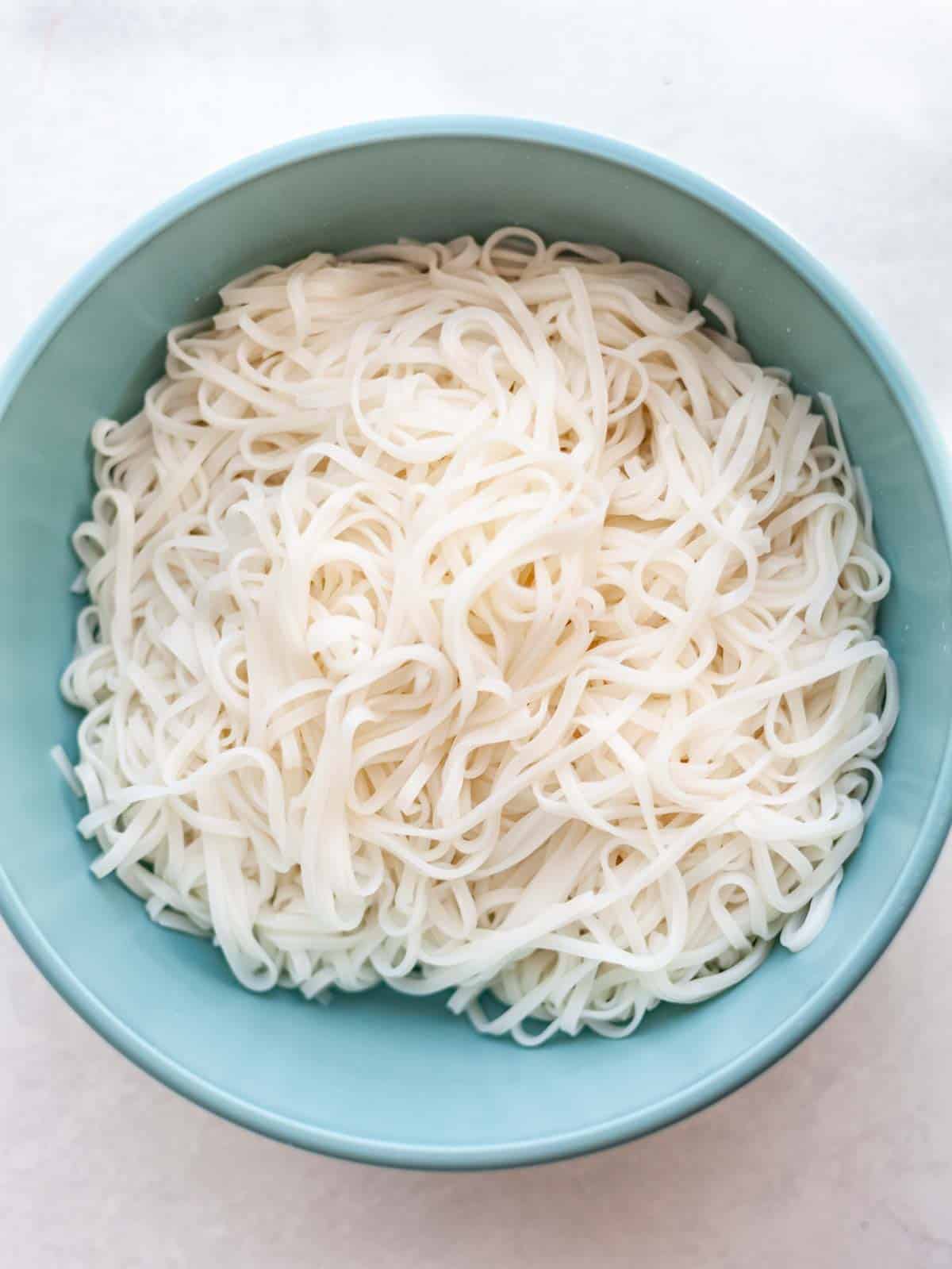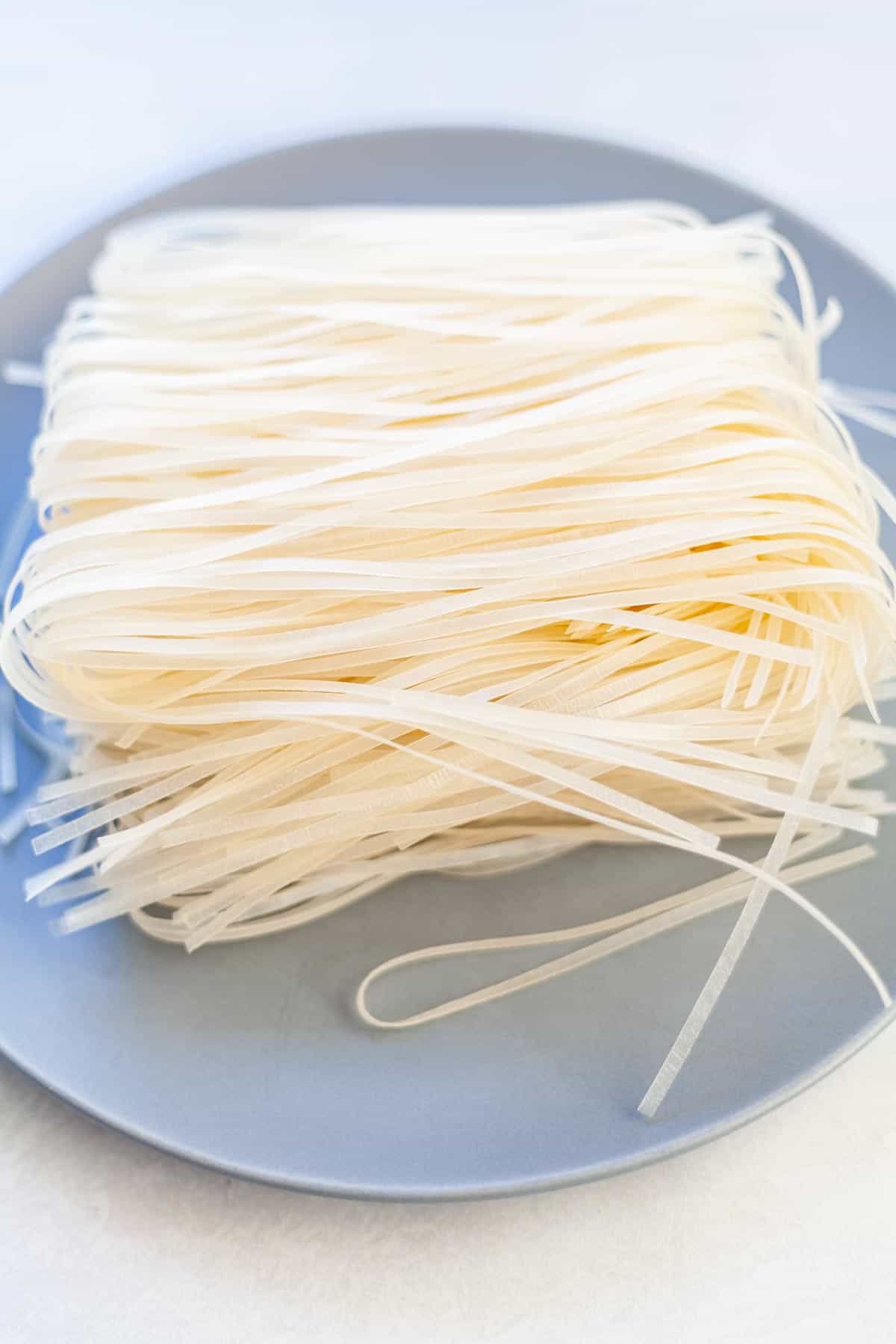For all of your favorite soup, stir-fry, and cold noodle salad recipes, learn how to prepare rice noodles!
Almost all Asian cuisines depend on the indispensable and delectable rice noodles, which are made with only two simple ingredients: water and rice flour.
I love rice noodles for their slightly chewy, springy texture. Additionally, they have a milder flavor than wheat-based noodles.
Like cold rice noodle salad with peanut lime dressing, cold rice noodle salads frequently have a salty, umami dressing with a kick of citrus and vinegar. We all enjoy rice noodle stir-fries like Pad See Ew and Drunken Noodles, which feature long, thin rice noodles.
Cooking rice noodles differs slightly from cooking other pasta varieties. Dried rice noodles are simply soaked in hot water to hydrate rather than being put through a boiling process. The hydrated noodles are then briefly cooked once more in a very hot wok or skillet if they are being used in a stir-fry.
Knowing how long to soak rice noodles before cooking is challenging. Read on for detailed instructions on how to prepare rice noodles for all of your favorite recipes.
How to Cook Rice Noodles
The “right” way to prepare dried rice noodles varies. There are several different but comparable techniques, and once you begin making rice noodles fairly frequently, you’ll find the technique you prefer.
Additionally, I’ve observed that some brands of rice noodles soften more quickly than others. If you find a brand you like, stick with it; eventually you’ll learn the ideal amount of time to soak your preferred rice noodles.
The most typical way to prepare dried rice noodles is described below, and is frequently listed on rice noodle packages:
Many home cooks and chefs prefer slightly different techniques.
Other Cooking Methods:
Hot water, longer soak: Some recipes, like this one for Pad Thai, use hot tap water (not boiling) and soak the noodles for up to 30 minutes. The noodles cook slightly slower, making it less likely theyll get too soft.
Use cold water and soak the noodles for a longer period of time. Even though it may take several hours or longer, you are less likely to end up with overly soggy noodles.
Immediately after a brief boil, immediately rinse the noodles with cold water. Careful with this method, as the noodles can easily over-cook.

The TL;DR is that Starch is attempting to ruin your day. Although it’s fantastic for giving rice noodles their pleasant texture, it also tends to become clingy. Like, really clingy. Get some sauce to put on those noodles to prevent the starch from sticking. If you do it correctly, you can keep the noodles separate while preparing the ingredients for your pad thai or curry. or eat gummy bears. Your call.
The most crucial thing you can do is to adhere to the directions on the package your noodles came in, which may seem obvious. The biggest mistake people make when cooking rice noodles is not cooking them for the recommended amount of time to achieve that satisfying chewiness (similar to al dente pasta). On the package, there are typically two sets of instructions: one for cold noodles and one for hot noodles. The cook time for cold noodles will typically be a little longer because the noodles won’t be cooked a second time like they would be if you were stir-frying them and because they will firm up a little bit when they cool.
After removing the noodles from the boiling water, you should immediately rinse them in cold water if you’re not using them right away or in a dish that is either cold or room temperature. The noodles won’t continue to cook because the cold water will cool them and remove any surface starch. After the noodles have been rinsed, combine them with a little oil in a bowl to further prevent sticking. Every five or ten minutes until you’re ready to use them, throw them away.
You’re asking the right questions, and the solutions are actually quite straightforward: how do we avoid the gummy? how do we get rice noodles not to stick together? how do we cook them properly for dishes like pad thai or green shrimp curry? Here are a few tips for using medium-sized, flat rice noodles, like pad thai noodles.
“Gummy” should be used to describe gum and gummy bears. It should never be used to describe noodles. But if you don’t know how to prepare rice noodles, chances are that they’ll frequently become gummy, giving you a huge clump of starchiness rather than a lovely tangle of glorious slippery strands. It should be noodles, plural—not noodle.
Types of Rice Noodles
Rice noodles are an ingredient in basically all Asian cuisines. They are sold fresh and dried. Dried rice noodles are the most popular type found in most grocery stores in the United States. Fresh rice noodles are more likely to be located in the refrigerator section in Asian markets.
Depending on the size and shape of the noodles, each nation has a different name for them. However, they are merely referred to as “rice noodles” or “rice stick” noodles in the majority of US grocery stores.
The width of the noodles is the primary distinction among all varieties of rice noodles.
The packaging rarely says exactly what size the noodles are. Luckily, the packaging is usually transparent so you can see the noodles for yourself! The brand “A Taste of Thai” has a good visual of all 4 widths of noodles that they sell.
4 common types of rice noodles
Although uncommon, brown rice noodles are also available in grocery stores. Regular rice noodles and brown rice noodles have very similar tastes and textures. The same methods for cooking and preparing regular rice noodles also work with brown rice noodles.

FAQ
How do I keep rice noodles from sticking together?
After the noodles have been rinsed, combine them with a little oil in a bowl to further prevent sticking. Every five or ten minutes until you’re ready to use them, throw them away.
Do you have to soak rice noodles before cooking?
Prior to stir-frying, dried noodles must be soaked in boiling water to soften them. Since they will cook while frying, fresh rice noodles, which are available at Asian grocery stores, don’t need to be soaked before being added to a stir fry.
How do you keep rice noodles from sticking on Reddit?
Just a little bit of olive oil in a bowl? Quickly run it under the faucet, then dry it out in the microwave for about a minute. I can remember my mom doing it since I can remember.
How do you make rice noodles not mushy?
Submerge them in room temperature water. Don’t boil rice noodles like you would pasta because they are so delicate. Why? Because boiling them will cause them to release too much starch, which is the main reason why stir-frying them makes them into a mushy mess.
